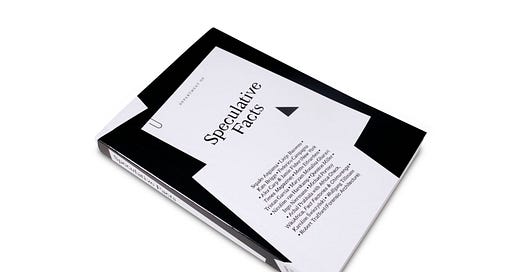Transmission 005
This is a newsletter for designers and time travel facilitators. It has insights about the speculative practice and tools we use in our method that they could try as well. Today it is windy.
Speculative scenarios are often unusual, curious, occasionally even disturbing, but desirable and attractive prompts that create the suspension of disbelief about change. They are open-ended, offer the audience the possibility of personal interpretation, and frequently include humor, which activates the audience on an emotional and intellectual level, in a way similar to literature and film.
Source.
The designer’s challenge during Phase 1 of time traveling (scenario design) is a difficulty from participants to come up with original stories, with stories distanced from utopia/dystopia, or when it feels intimidating to blurt out new storylines.
Here are writing prompts that could rescue you, this week from our minds.
“There was once a bed built to reach impossible symmetries. For instance, if you slept on its left side you would dream with the letter ‘d’; if the next night you slept on the right side, you’d dream with the letter ‘b’.
You happen to like to sleep on your back? Dreams of even numbers would appear. Sleeping on your belly? Odd numbers.
If you moved from side to side while sleeping you’d dream of palindromes. One night it was my turn to sleep there, and I slept upside down to give it a proper test.”
Phase 3 of time traveling is about rapid-prototyping. Artifacts are a view into a time traveler’s heart and soul (and values and fears and hopes and a conviction that they are indeed creative, a conviction which we as designers must protect at all times).
This is how we make artifacts rapidly, how prototyping works at The Time Travel Agency, or how this weird stuff is created.
In speculative design we communicate ideas with artifacts. During rapid prototyping we think with our hands and build physical or digital objects that contain a fiction, a scenario, a challenge inside that scenario, and a proposed answer.
During facilitations, designers sometimes have trouble when individuals censor their ideas because of current limitations in technology, which in turn brings a predictable conversation about the tech giants that detours innovative (and wishful) thinking. Our usual move is to push their concept outside of what is possible (outside of the possible futures, from the futures cone) and go immediately to building.
Here’s an example of an artifact: The Transcending Pillow, “a soft nanotissue pillow [that] gives citizens the opportunity to download selected work from their day into their minds as they sleep.”
Focusing on physically building the packaging of where such a pillow would come in the mail unlocked the roadblock this time. Suddenly we’re talking about why we need to prioritize information and why bragging about working despite a lack of sleep is not helpful.
The pillow is part of a series of artifacts from The Laboratory of Optimistic Futures and has a 3D sibling which you can use to play on Instagram (under our filters).
When we make 3D artifacts that we deliver a few weeks after a time travel, they bring excitement and a rekindling of creative memories in our clients.
What we see when we aren’t seeing into a specific project.
We borrow from film, literature, games, the zeitgeist, the bus…
Tales from the Loop is a super series that blends sci-fi, slowness, and emotion. It is also an RPG whose book has locations, characters, challenges, and mysteries plus how to make more, which is why it’s a designer’s helpful guide to craft experiences that time travelers could shape, while providing them with rules of the universe they’re creating in front of you. Perfect for improvising games and stories.
From our community!
“The Department of Speculative Facts connects two seemingly contradictory approaches: Speculation which attempts to think and act beyond existing knowledge and structures, and fact-checkers in search for a solid consensus on which our reality can be built. When stretching knowledge and speculating with fiction, what sense of responsibility is needed in times of democratized opinions and fake news? Learning from the other SF—Science Fiction—we think of speculation through facts, and facts through speculation, to situate truth culturally.”
This piece was created from an e-mail exchange between two fact-checkers from the New York Times Magazine, which the editors handed over to artists to re-write, re-perform, and re-design. Exploring this piece is a wonderful experience of how we time travel in speculative design at the studio: present – future – past (present).












